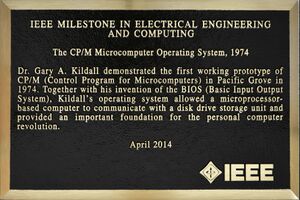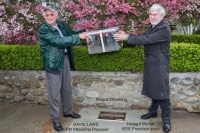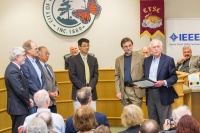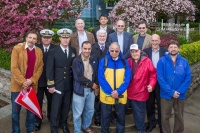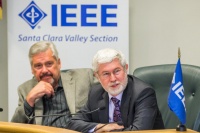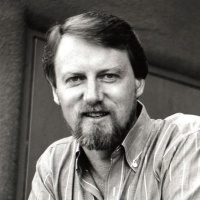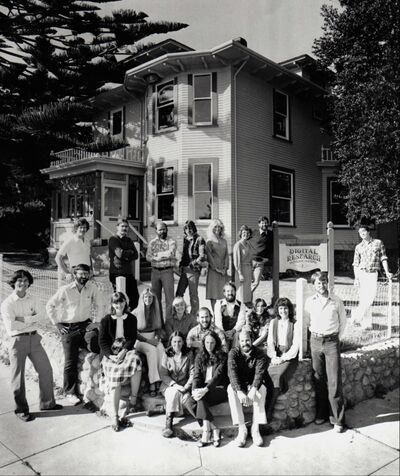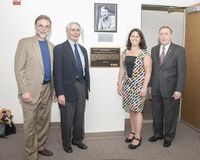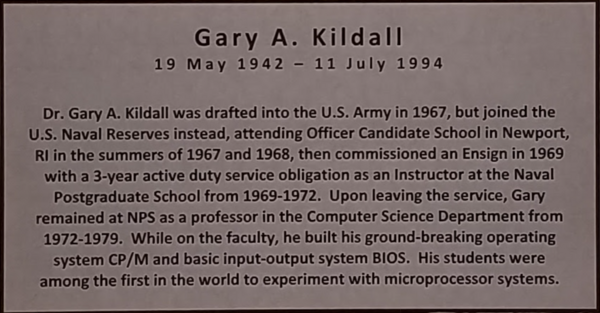Milestones:The CP/M Microcomputer Operating System, 1974
- Date Dedicated
- 2014/04/25
- Dedication #
- 139
- Location
- Pacific Grove, California, U.S.A.
- IEEE Regions
- 6
- IEEE sections
- Santa Clara Valley
- Achievement date range
- 1974
Title
The CP/M Microcomputer Operating System, 1974
Citation
Dr. Gary A. Kildall demonstrated the first working prototype of CP/M (Control Program for Microcomputers) in Pacific Grove in 1974. Together with his invention of the BIOS (Basic Input Output System), Kildall’s operating system allowed a microprocessor-based computer to communicate with a disk drive storage unit and provided an important foundation for the personal computer revolution.
Street address(es) and GPS coordinates of the Milestone Plaque Sites
- Site 1: 801 Lighthouse Avenue, Pacific Grove, CA 93950 US (GPS: 36.623549,-121.923315)
- Site 2: Naval Postgraduate School (NPS), 1 University Circle, Monterey, CA 93943 US, (GPS: 36.597916, -121.874177)
Details of the physical location of the plaque
- Site 1: The plaque is mounted at the edge of the public sidewalk adjacent to a retaining wall surrounding the property, which is a private residence.
- Site 2: On the wall of the Dr. Gary A. Kildall Memorial Conference Room in Glasgow Hall.
How the plaque site is protected/secured
- Site 1: The plaque is viewable 24/7, but the building residents should not be disturbed.
- Site 2: The plaque is not generally accessible to the public.
Historical significance of the work
CP/M (Control Program for Microcomputers) was the first commercial operating system to allow a microprocessor-based computer to interface to a disk drive storage unit. CP/M played an important role in stimulating the hobbyist personal computer movement of the 1970s. Its ability to support software programs on a wide variety of hardware configurations enabled early use of microcomputer systems from many different manufacturers in business and scientific applications. Microsoft DOS, as licensed to IBM for the original PC, was written to emulate the look and feel of CP/M. Thus, CP/M was the forerunner of the operating systems that now power the majority of the world's computers, and led to the personal computing revolution.
Obstacles (technical, political, geographic) that needed to be overcome
The major challenge that Kildall had to overcome in the development of CP/M was the design and debugging of the “complex electronics ... to make the diskette drive find certain locations and transfer data back and forth”. The following recollections are abstracted from pages 53-55 of "Computer Connections", an unpublished autobiography that he wrote and distributed to friends and family in 1994. "Memorex ... had come up with the new "floppy disk" to replace IBM punched cards. I stared at that damn diskette drive for hours on end ... trying to figure a way to make it fly. I tried to build a diskette controller … but I, being mainly hardware inept … couldn’t get my controller to work. So I built an operting (sic) system program ... I called it CP/M [but] I just couldn't figure out how to make that damn disk drive work. Out of frustration, I called my good friend from the University of Washington, John Torode. He designed a neat little microcontroller and after a few months of testing that microcontroller started to work. We loaded my CP/M program from paper tape to the diskette and "booted" CP/M from the diskette, and up came the prompt *. This may have been one of the most exciting days of my life."
Features that set this work apart from similar achievements
Before Kildall’s development of CP/M, computer manufacturers provided proprietary applications software that worked only on their own hardware. All programs had to be written from the ground up to operate on each unique machine configuration. CP/M was initially designed to work on the Intel 8080 microprocessor and allowed computer systems built by any manufacturer who used that chip to run applications programs written by third-party suppliers. CP/M introduced a new element of competition into the computer marketplace that stimulated rapid growth in the use of low-cost systems in business, industry and academia and eventually in the home. According to Kildall, “CP/M was an instant success. By 1980, DRI had sold millions of copies of CP/M to manufacturers and end-users.”
Significant references
- David A. Laws: Gary Kildall and Digital Research Inc.: The Birth of the PC Operating System
- Gary Kildall Conference Room Dedication at Naval Postgraduate School (April 21, 2017):
Supporting materials
Kildall’s autobiography “Computer Connections” notes on page 55 that he solicited the help of John Torode in 1974. He gives no specific date but recalls that “This was in the late afternoon and … John and I retired to have a Chinese dinner in Pacific Grove”. E-mail correspondence from John, dated June 24, 2013, places the time frame as follows: “My wife and I concur that it was probably after our wedding on June 22 1974, but before we moved to Chicago (she worked for Bell Labs) in the fall”.
Kildall’s own public account of the history of CP/M was published in Dr Dobbs Journal in 1980: THE EVOLUTION OF AN INDUSTRY: ONE PERSON'S VIEWPOINT, "Dr. Dobb's Journal of Computer Calisthenics & Orthodontia", Vol.5, No.1, (January 1980) (number 41), page 6-7 [1]
Numerous popular accounts of the history of CP/M have been published in newspaper and magazine articles and in books, as well as online. Most of them focus on the fictitious story that DRI lost out to Microsoft on the IBM PC operating system decision because Kildall had taken the day off to go flying. Kildall refutes this story in “Computer Connections” but it is probably most eloquently recounted in Harold Evans’ book on U.S. pioneers and innovators “They Made America.” Harold Evans, “They Made America: Two Centuries of Innovators from the Steam Engine to the Search Engine” (2004) ISBN 0-316-27766-5 [2]
Steve Ham and Jay Greene, “The Man Who Could Have Been Bill Gates,” Bloomberg Business Week, 24 October 2004. [3]
Online only sources
CP/M and Digital Research Inc. (DRI) Web pages [4]
CP/M [5]
Gary Kildall Special (Video) [6]
A Short History of CP/M [7]
Gordon Eubanks Oral History (Computerworld 2000) [8]
Computer History Museum story [9]
Dedication Ceremony
The dedication of the IEEE Milestone generated some wonderful coverage for IEEE and technical history. The Monterey, California NPR station KAZU-FM posted the following story by Krista Almanzan: "Recognizing the Legacy of Pacific Grove Inventor Gary Kildall." Included with this story is an audio clip that was broadcast three times on 24 April 2014 (the day before the dedication). Almanzan sums up part of Gary Kildall's legacy as: Kildall, who passed away in 1994, has often been referred to "as the man who could have been Bill Gates," if not for one missed opportunity. But those who knew him best hope Friday's dedication will begin to change that legacy. Recognizing the Legacy of Pacific Grove Inventor Gary Kildall http://kazu.org/post/recognizing-legacy-pacific-grove-inventor-gary-kildall
On 2 May 2014 (one week after the dedication) NPR stations throughout California broadcast an audio clip that included comments from the dedication and unveiling ceremonies by IEEE President-Elect Howard Michel and Gary Kildall's daughter Kristin. "Pacific Grove Inventor Finally Honored for Creating First PC Operating System" http://www.californiareport.org/archive/R201405020850/a
See also http://blogs.kqed.org/newsfix/ieee-recognizes-gary-kildall-for-pioneering-computer-operating-system
Dr. Gary A. Kildall Memorial Conference Room Dedication
Further Reading
Legacy of Gary Kildall Facebook page
"Gary Kildall Legacy": IT History Society Blog by Alan Weissberger
Gary Kildall Obituary by John Wharton
IEEE The Institute: Groundbreaking Operating System Is Named an IEEE Milestone
IEEE History Center newsletter coverage of CP/M Milestone (p. 3)
Map
